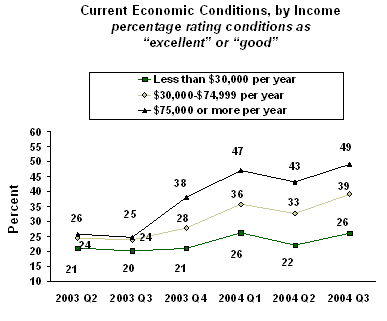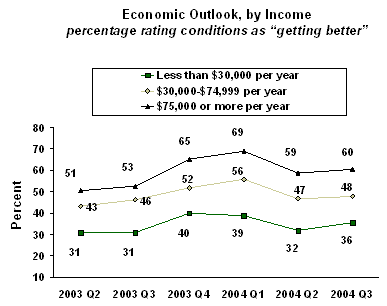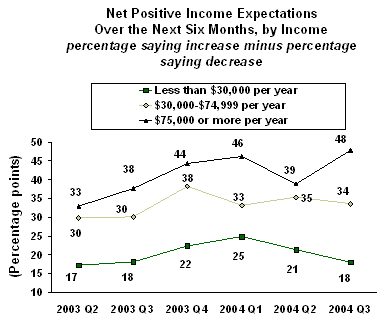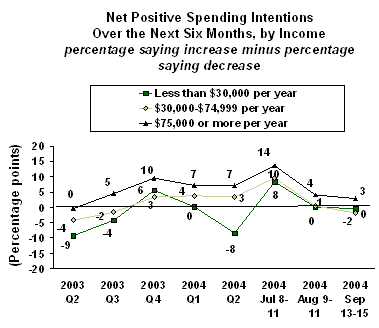GALLUP NEWS SERVICE
PRINCETON, NJ -- New Gallup Poll economic data show consumers rating economic conditions in the third quarter of 2004 slightly higher than they did in the first quarter, and at their best level in more than two years. Consumer expectations for the future of the economy are at about the same level as last quarter, but remain down from where they were during the first quarter of this year.
Does this mean the so-called "soft patch" in consumer spending is coming to an end, as Federal Reserve Board Chairman Alan Greenspan has suggested? Does this increase in consumer confidence validate the Federal Open Market Committee's intention to increase interest rates once more at its Tuesday meeting?
Gallup's consumer income expectations and consumer spending intentions measures both provide some surprising answers, particularly when they are analyzed by consumer income levels.
Many Consumers See Better Economic Conditions
Nearly half of upper-income consumers (those earning $75,000 or more a year) rated current economic conditions as "good" or "excellent" during the third quarter of 2004. This is slightly higher than the 47% who provided similar ratings during the first quarter, and nearly twice the percentage of these consumers who rated economic conditions this way during the second and third quarters of 2003.
Four in 10 middle-income consumers (those earning at least $30,000 but less than $75,000 annually) offered similarly strong ratings for the economy during the third quarter of this year. This is about 1.5 times the number who provided good or excellent ratings a year ago.
One in four lower-income consumers -- those earning less than $30,000 a year -- rated current economic conditions as good or excellent this quarter. This is up about five percentage points from the second and third quarters of 2003.

Many Consumers Also See the Economy Improving
Six in 10 upper-income consumers say economic conditions are "getting better." This is about the same as last quarter and down nine percentage points from the first quarter. Still, it is up seven points from the third quarter of 2003.
Roughly half of all middle-income consumers say current economic conditions are getting better, about the same as last quarter and only two percentage points above a year ago.
In contrast, only one in three lower-income consumers also say current economic conditions are getting better, up four percentage points from last quarter and five points from the third quarter of last year.

Consumers' Income Expectations Differ
In the third quarter of 2004, in terms of income expectations, 52% of upper-income consumers said they expected their incomes to increase over the next six months, and 4% expected them to decrease, yielding a net positive score of 48 percentage points. This is the highest net positive percentage in more than a year, and 10 percentage points higher than during the third quarter of 2003.
For middle-income consumers, the net difference between those who expected an increase in income over the next six months and those who expected a decrease is 34 percentage points -- up four points from a year ago.
And the net positive percentage for lower-income consumers during the third quarter was 18 percentage points -- the same as at this time a year ago.

Consumer Spending Intentions Tumble
In July, there was a surge in consumer spending intentions across all income groups. Since then, however, consumer spending intentions have plunged.
For upper-income consumers during September, there was a difference of only three percentage points between the percentage who said they intended to increase their spending over the next six months and the percentage who said they planned to decrease it. This is a smaller difference than was the case during the third quarter of 2003.
In September, more middle-income consumers said they intended to decrease their spending than said they would increase it during the next six months, a difference of –2 percentage points. This is identical to the –2 percentage-point difference of last year's third quarter.
About the same percentage of lower-income consumers in the current poll said they planned to decrease their spending over the next six months as said they planned to increase it. This is better than the –4 points of a year ago.

The Income Squeeze Has Consequences
The slow recovery in the job market affects more Americans than merely those who are unemployed. Current job market conditions clearly benefit employers and disadvantage employees. As a result, it should not be surprising that employee incomes are not rising nearly as quickly as might be expected during the third year of an economic recovery. Nor should it be unexpected that consumers are moderating their income growth expectations in light of this reality.
The Energy Department reports that the mid-September average price for all grades of gas at the pump is about $1.89 a gallon -- up 24% this year. Clearly, this adds to the squeeze on consumers as it reduces their disposable income available for other purchases. With oil prices remaining over $40 a barrel, consumers can't be too optimistic that gas prices will plunge anytime soon.
In this regard, it is little wonder that lower- and middle-income families are much less optimistic about both current economic conditions and the economic outlook than are their upper-income counterparts. And it should not be surprising that Gallup's economic data show that the squeeze is at its worst for lower- and middle-income families.
In September, only 29% of lower-income consumers expected an income increase over the next six months, and 17% expected a decrease, for a net positive score of 12 percentage points -- down from 20 points in August and 22 points in July. During the same month, middle-income consumers had a net positive score of 31 points -- up 2 points from August but down 11 points from July. Still, in September, the net positive score for upper-income consumers was 48 points -- unchanged from July and August.
At the same time, high gas prices have had a disproportionately negative impact on lower- and moderate-income consumers. A June Gallup Poll revealed that more than half (55%) of lower-income consumers have had to cut back significantly on their household spending because of rising gas prices. In sharp contrast, only 15% of upper-income consumers have had to do likewise.
Combine the much weaker income expectations of lower- and moderate-income consumers with the greater relative gas-price hardship, and a decline in spending intentions among lower- and middle-income consumers seems logical.
On the other hand, upper-income consumers remain much more optimistic about the economy and their incomes. As a result, the sharp drop-off in spending intentions among this group is particularly disturbing. The high price of gas is probably playing a role, but what else is leading those in this group to hold back on spending? Could it be a fear of higher interest rates?
Bad News for Retailers and Political Incumbents
The drop in consumer income expectations and spending intentions during the past couple of months belies the idea that today's consumer confidence levels will lead us past the "soft patch" in consumer spending. Instead, the data suggest that retailers will continue to underperform during the weeks ahead.
While the Fed's expected increase in interest rates won't necessarily make things worse in the immediate term, it is not helpful, as it suggests that the nation's monetary authorities are more optimistic about consumer incomes and spending than are consumers themselves.
Those most at risk, however, may be political incumbents. While consumer confidence is relatively high as the presidential elections approach, lower- and middle-income consumers are clearly encountering significant pocketbook frustrations. Although 2004 may well be an exception, incumbents have good reason to be concerned because consumers often take out their pocketbook frustrations on those in political office.
Survey Methods
Results are based on telephone interviews with 1,022 national adults, aged 18 and older, conducted Sept. 13-15, 2004. For results based on this total sample, one can say with 95% confidence that the margin of sampling error is ±3 percentage points. In addition to sampling error, question wording and practical difficulties in conducting surveys can introduce error or bias into the findings of public opinion polls.

